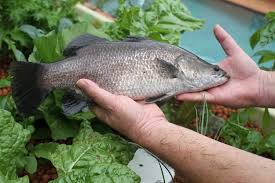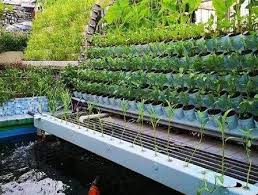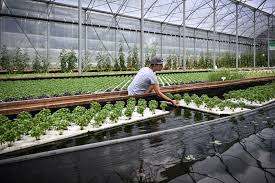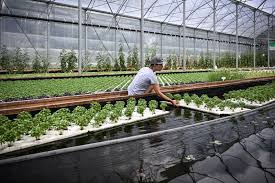Aquaponics is an innovative farming method that combines aquaculture (raising fish) and hydroponics (growing plants without soil) in a single, integrated system.
This technique leverages the natural relationship between fish and plants, where the fish provide nutrients for the plants, and the plants, in turn, purify the water for the fish.
Aquaponics is gaining attention as a sustainable and efficient method of food production, offering a solution for areas with limited water, land, and soil resources.
The Basics of the Aquaponics System
Aquaponics systems consist of several key components:
1. Fish Tank: This is where the fish are raised, providing nutrients in the form of waste.
2. Grow Beds: Plants are grown in these beds, absorbing the nutrients from the water.
3. Water Pump: This circulates water between the fish tank and the grow beds.
4. Biofilter: Converts fish waste (ammonia) into nitrates, which are usable by plants.
The entire system relies on the continuous circulation of water, which ensures that fish waste is constantly being filtered by the plants, keeping the water clean and nutrient-rich for plant growth.
Symbiotic Relationship Between Fish and Plants
The core of aquaponics is the symbiotic relationship between fish and plants:
1. Fish produce waste in the form of ammonia, which is toxic to them if allowed to accumulate.
2. Beneficial bacteria in the biofilter convert ammonia into nitrates, a nutrient that plants need for growth.
3. The plants absorb these nitrates from the water, effectively removing the waste and purifying the water for the fish.
This natural cycle allows both the fish and plants to thrive without the need for chemical fertilizers or complex waste management systems.
Role of Fish in Aquaponics

Fish play a vital role in providing nutrients to the plants. Their waste is rich in ammonia, which is broken down into nitrates by bacteria. The type of fish used in an aquaponics system can vary, but commonly used species include:
1. Tilapia: A hardy and fast-growing fish that is highly adaptable to different water conditions.
2. Trout: Preferred in colder climates, trout thrive in cooler water temperatures.
3. Catfish: Known for their resilience and ability to survive in varying water conditions.
The choice of fish depends on factors like water temperature, system size, and the specific goals of the aquaponics farm.
Role of Plants in Aquaponics
Plants in aquaponics serve as natural filters for the water. As they absorb nutrients from the water, they clean and purify it for the fish. Many types of plants can be grown in aquaponics systems, including:
1. Leafy Greens: Lettuce, spinach, and kale are common choices due to their fast growth and low nutrient requirements.
2. Herbs: Basil, mint, and parsley grow well in aquaponic setups.
3. Fruiting Plants: Tomatoes, cucumbers, and peppers can also be cultivated, though they may require more space and nutrients.
The plants benefit from a constant supply of nutrient-rich water, leading to rapid and healthy growth without the need for synthetic fertilizers.
Benefits of Aquaponics
Aquaponics offers numerous advantages over traditional farming and standalone aquaculture or hydroponic systems:
1. Water Efficiency: Aquaponics uses up to 90% less water than traditional farming, making it ideal for areas with limited water resources.
2. No Need for Chemical Fertilizers: The fish waste provides all the nutrients that plants need, eliminating the need for synthetic fertilizers.
3. Sustainable Food Production: Aquaponics creates a self-sustaining system where both plants and fish thrive, offering a continuous supply of food.
4. Faster Plant Growth: The constant supply of nutrients from the fish waste promotes faster growth in plants compared to traditional soil-based farming.
5. Waste Reduction: Aquaponics minimizes waste by recycling fish waste into plant nutrients, reducing the environmental impact of both aquaculture and agriculture.
Read Also: Rose Chafer: Description, Damages Caused, Control and Preventive Measures
Types of Aquaponics Systems

Aquaponics systems come in different designs based on the type of water circulation and plant support used. The main types include:
1. Media-Based Systems: Plants grow in a medium like gravel or clay pebbles, and the fish water flows through the medium, providing nutrients. It’s simple and ideal for beginners.
2. Nutrient Film Technique (NFT): Water flows continuously through channels that hold plant roots, allowing them to absorb nutrients. This method works best for lightweight, fast-growing plants like lettuce.
3. Deep Water Culture (DWC): Plants float on rafts with their roots submerged in water. This method is popular in large-scale systems due to its high efficiency.
4. Hybrid Systems: A combination of media-based, NFT, and DWC, hybrid systems are designed to maximize efficiency and flexibility for different types of plants.
Setting Up an Aquaponics System
Setting up an aquaponics system involves several key steps:
1. Choosing a Location: Select an area with sufficient sunlight, proper ventilation, and easy access to water. Indoor or greenhouse setups can provide better control over temperature and humidity.
2. Selecting Fish and Plants: Choose compatible fish and plants based on climate, system size, and personal preferences. Tilapia and leafy greens are common choices for beginners.
3. Installing Components: Set up the fish tank, grow beds, biofilter, water pump, and aeration system. Ensure water flows smoothly between the components.
4. Cycling the System: Before adding fish and plants, cycle the system for several weeks to establish beneficial bacteria, which convert fish waste into plant nutrients.
5. Adding Fish and Plants: Once the system is cycled, introduce fish into the tank and plants into the grow beds. Monitor their health and growth regularly.
Read Also: Bedbugs: Description, Damages Caused, Control and Preventive Measures
Maintenance of Aquaponics Systems

Maintaining an aquaponics system is crucial for ensuring its long-term success:
1. Water Quality Management: Regularly test the water for pH, ammonia, nitrite, and nitrate levels. Adjust these levels to keep the fish and plants healthy.
2. Feeding the Fish: Feed the fish an appropriate diet based on their species. Avoid overfeeding to prevent water contamination.
3. Cleaning Filters: Clean the biofilter and other system components periodically to prevent clogs and maintain efficient water circulation.
4. Monitoring Plant Growth: Check the plants for nutrient deficiencies, pests, and diseases. Adjust the water flow or nutrients as needed.
5. Checking Pumps and Aerators: Ensure that pumps and aerators are functioning correctly to maintain oxygen levels for both fish and plants.
Challenges in Aquaponics
While aquaponics offers many benefits, it also presents challenges:
1. Initial Costs: Setting up an aquaponics system can be expensive due to the cost of tanks, pumps, and grow beds.
2. Technical Knowledge: Managing water quality, nutrients, and system balance requires knowledge and attention.
3. Disease Control: Fish and plant diseases can spread quickly in closed systems, so regular monitoring and quick action are needed.
4. Power Dependency: Aquaponics systems rely on electricity to circulate water and maintain oxygen levels, making them vulnerable to power outages.
5. Market and Consumer Acceptance: Aquaponic products are still new in some markets, so consumer awareness and demand may be limited.
The Future of Aquaponics
The future of aquaponics looks promising, with advancements in technology and growing interest in sustainable agriculture. Innovations in automation, smart sensors, and data analytics will improve system efficiency and scalability.
As global concerns about food security, water conservation, and environmental sustainability grow, aquaponics has the potential to become a mainstream farming method, offering fresh, locally produced food in both urban and rural settings.
Aquaponics could also play a key role in addressing climate change by reducing the need for soil-based farming, cutting water usage, and minimizing the environmental impact of traditional agriculture.
As research and development continue, aquaponics will likely evolve to become even more accessible and efficient for both small-scale and commercial farmers.
Aquaponics represents a sustainable and innovative approach to food production, based on the natural, symbiotic relationship between fish and plants.
This integrated system not only conserves water and resources but also eliminates the need for chemical fertilizers, offering a solution for eco-friendly and efficient farming.
As interest in sustainable agriculture grows, aquaponics continues to be a promising option for both small-scale urban farmers and larger commercial operation
Do you have any questions, suggestions, or contributions? If so, please feel free to use the comment box below to share your thoughts. We also encourage you to kindly share this information with others who might benefit from it. Since we can’t reach everyone at once, we truly appreciate your help in spreading the word. Thank you so much for your support and for sharing!
Read Also: How to Graft an Avocado Tree to Produce Avocado Fruit

